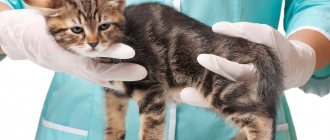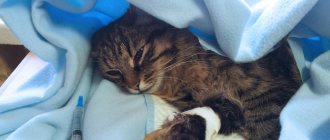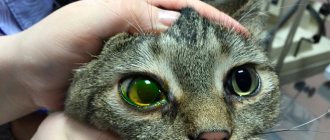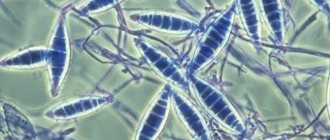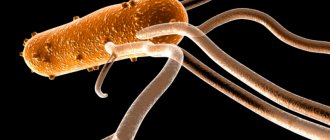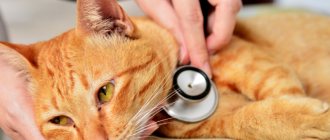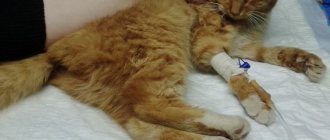Often, owners of domestic cats associate the word parasite with helminths. In fact, protozoa can cause more serious harm to a cat’s health. The symptoms and treatment of protozoa in cats have been well studied, and we will talk about this today in this article.
Protozoa in cats are represented by unicellular and colonial organisms that lead a parasitic lifestyle in the animal’s body. These protozoa cause diseases that have another name - protozoal infections. The most common of them:
- amoebic dysentery or amoebiasis;
- toxoplasmosis;
- trematodes;
- isosporosis;
- coccidiosis;
- Giardiasis, better known as giardiasis.
How does protozoa infection occur?
A cat can become infected after eating food or water contaminated with parasite spores. Another route of transmission is the bites of blood-sucking insects. At risk are kittens that still have weak immunity and animals that have recently undergone illness or surgery; they also still have weak immunity. Protozoa in cats are also dangerous for humans. Therefore, when treating pets for protozoa and disinfecting the premises, certain safety rules must be followed. This is especially important if there are children or elderly people in the house. In this case, the sick animal will need to be isolated.
Common Cat Diseases
When deciding to have a pet, a person takes on a number of obligations. A kitten or an adult cat needs care; like all living beings, it can encounter diseases.
That is why in everyday life you need to pay attention to his well-being, playfulness, and appetite. There are a huge number of cat diseases in the world. If the behavior has somehow changed, then you can suspect problems.
The best solution in this case would be to contact a specialist.
If you notice the following signs, you should visit a veterinarian:
- Vomiting, excessive drooling
- Lethargy
- The desire to hide in a dark corner
- Discharge from eyes and nose, cough
- Lost appetite, weight loss
- Convulsions
Important: The normal body temperature of a cat is 37.5 - 39 degrees Celsius, moreover, in young cats and kittens it is within the upper limit, and in older cats it is within the lower limit. The breathing rate of a kitten is about 60 breaths per minute, in young individuals it is 22-24 breaths, and in adults it is 17 - 23. Normal heart rate for cats is 100 - 130 beats per minute.
How quickly you respond to a problem will directly affect your pet’s health. Therefore, try to pay attention to it when the cat’s disease is still at an early stage. So vomiting may be a sign that too much hair has accumulated in the stomach.
In this case, it is recommended to give your friend a special paste that will dissolve the fur. But regular vomiting is not a good sign; if it occurs, you need to consult a specialist. Vomiting can occur with worms, due to disruption of the intestines.
Remember that self-medicating animal diseases is quite dangerous.
Below is information about the most common diseases of cats and cats.
Among the common ailments are problems with the urinary system. Cystitis or urolithiasis may occur, which may result in your four-legged friend walking past the litter box.
There may also be a strong odor and blood in the urine. This is not a dangerous disease, but it can cause more serious negative consequences. By the way, this manifests itself due to sand in the bladder, diabetes, and lack of fluid.
Amoebic dysentery
The amoeba Entamoeba histolytica, entering the cat's body, causes disease. The main symptom is prolonged diarrhea. As a result, inflammation of the colon occurs. People, dogs, cats and some other animals are at risk. Often, a person can be a source of protozoan infection for his pets, even if he himself is not sick, but is only a carrier of these protozoa.
The localization zone of this parasite is the large intestine; in some cases, the disease can be asymptomatic when it enters the chronic stage or with pronounced diarrhea. In the absence of treatment and with incorrectly selected therapy, the cat quickly loses appetite and weight. Stool samples are taken for diagnosis, and antibiotics are often prescribed for treatment.
Features of oocysts
Mostly infected animals and people suffer an acute form of the disease, although the development of chronic isosporosis cannot be ruled out. At the first suspicious signs, you must contact a medical facility for examination.
Blood and stool tests are used to identify signs of the presence of the parasite in the body. If more than 10 cystoisospores are detected in a sample in the field of view of the microscope, a diagnosis of “isosporosis” is established.
To confirm the diagnosis, a microscopic examination of the patient's stool samples is performed.
Isosporosis in humans lasts about two weeks. Sometimes a cholera-like course of the disease may occur, accompanied by fever. To clarify the diagnosis, procedures such as a biopsy of the jejunum (the middle section of the small intestine) and duodenal intubation may be prescribed.
Antimicrobial and specific antiprotozoal drugs, as well as some antimalarial drugs, are used for treatment. The following products have proven themselves to be effective:
- Co-trimoxazole;
- Metronidazole;
- Fazizhin;
- Fansidar.
The drug Co-trimoxazole (Biseptol) is used for treatment.
Treatment of isosporosis in dogs and cats is carried out in a veterinary clinic after conducting the necessary microscopic examinations. Often, animal owners seek help after the disease has become chronic, which significantly complicates therapy.
The general principle of treating isosporosis in cats and dogs is not very different. Animals are given symptomatic and etiotropic therapy, and their feeding and living areas are also disinfected.
Hunting dogs are most susceptible to infection with isosporosis.
The doctor will determine how to treat isosporosis in a cat or dog. The most commonly used are nitrofurans, coccidiostatics and sulfonamides. It will also not be superfluous to carry out anthelmintic measures.
In appearance, oocysts are bodies up to 33x19 microns in size, oval in shape, at the end of which there are two ends, slightly narrowed. Oocysts have a pale, smooth shell. Such isosporosis pathogens can even live in the soil for a long time before they enter the human or animal body.
But isospore in the body does not always cause illness and leads to disruption of the gastrointestinal tract. Often people, cats, and dogs are simply carriers of such a pathogen for a long time. If a cat has a strong immune system, its physical condition will not change. But the situation is completely different with pets that are weakened by long-term illnesses or have a weak immune system from birth.
In this case, the oocysts begin to actively influence the body. What happens to a kitten or weak adult animal? His digestion process is significantly disrupted, and also, which is no less dangerous, nutrients are not absorbed correctly.
Trematodes
The localization of these protozoa can be in the intestines, liver or pancreas. The route of entry is through an intermediate host, which can be mice, other types of rodents, frogs, which cats like to hunt. Protozoa are usually found in a cat’s feces when it is submitted for diagnosis. The main symptoms include
- nausea;
- vomit;
- loss of appetite;
- weight loss;
- diarrhea;
- lethargic state;
- development of enteritis.
Giardia intestinalis (Giardia intestinalis)
Giardiasis is a fairly common protozoal disease. It is promoted by crowded housing and poor feeding, which is why kittens adopted from shelters almost always suffer from it. Adults are practically not affected, but with the slightest decrease in immunity, Giardia begins to intensively damage the intestines. As a result - diarrhea, vomiting, apathetic state and refusal to feed. In kittens, the disease is much more severe; young pets often die from dehydration, intoxication and, in the long term, sepsis.
Please note that giardiasis can be transmitted to people!
In obvious cases of giardiasis, the clinical picture is as follows:
- Intermittent diarrhea . Those. The animal may seem quite healthy and happy with life, but from time to time it suddenly develops profuse and watery diarrhea, and there is mucus in the stool. Feces give off a disgusting smell. Since this rarely happens at first, the owners are not particularly worried: they believe that their pet “ate something wrong.”
- Apathetic state . The animal is indifferent to everything that happens around it, practically not reacting to loud sounds and attempts to play with it.
- Vomit.
- Chronic weight loss. This happens because parasites severely damage the intestines, which then cannot properly absorb nutrients.
- Feces are extremely unpleasant and smell disgusting.
- The cat constantly has flatulence .
If you observe a combination of these clinical signs in your cat, you should immediately take him to the veterinarian. The diagnosis is made on the basis of microscopic analysis of stool and scrapings from the intestinal mucosa.
Coccidiosis
Protozoa called coccidia infect the epithelial layer of the intestine. It is extremely difficult to establish a diagnosis, since in most cases there are no symptoms, in the most severe cases diarrhea begins, sometimes mixed with blood, resulting in dehydration and sudden weight loss. Young animals and animals with poor immunity are most susceptible to damage. Poor living conditions for cats also contribute to the spread of the disease. For diagnosis, fecal fragments are examined. For prevention, it is important to follow the rules for keeping cats and feeding them.
Contraindications and side effects
The drug is not recommended for the treatment of pregnant and lactating cats and dogs, animals with individual intolerance to the active components of the drug, pets with renal and liver failure. For folate deficiency anemia and a history of severe allergies, the medicine is given with caution and under the supervision of a veterinarian.
Side effects from taking the drug include:
- gastrointestinal reaction (nausea, vomiting, dyspepsia, etc.);
- renal dysfunction;
- allergic reactions;
- arthralgia;
- cough, shortness of breath;
- violation of the blood formula.
In case of an overdose of the drug, all side effects will be more pronounced. When large doses of medicine are given to an animal, it is given a gastric lavage and taken to a veterinarian.
Lambiasis
With this disease, the small intestine is damaged by protozoan parasites. Infection occurs through consumption of water and food contaminated with Giardia protozoa. A person can also become infected from a cat, so you need to be extremely careful when cleaning the cat's litter box. Symptoms include changes in stool, diarrhea or diarrhea, and sometimes worms are visible in the stool. As we see, protozoan parasites and pathologies in cats are mutually related. And in order to begin proper treatment, you need to conduct an accurate diagnosis of which protozoan caused a specific disease.
Babesiosis
The disease is caused by a protozoan called Babesia. The main route of transmission is from ixodid ticks, through their bites. The incubation period usually passes without symptoms. Animals with strong immune systems can survive the disease itself asymptomatically, while cats with weakened immune systems may face death. The main symptoms include darkening of urine, fever, and enlarged lymph nodes. Loss of appetite and, as a result, weight.
Treatment
There are many methods for treating protozoa in cats, it all depends on the type of pathogen, the severity of the disease and symptoms.
For example, drugs such as metronidazole and fenbendazole are often prescribed to treat giardiasis. In some cases, the use of one drug may be sufficient. If the disease is severe and accompanied by vomiting and diarrhea, then the doctor may additionally prescribe detoxification medications.
There are also broad-spectrum drugs that are effective against all protoses. For example, veterinarians will often prescribe the drug chemical coccide. It should be given to the cat mixed in food for 3 days. Dosage 24 mgkg. Sometimes it becomes necessary to take the drug again; it will be prescribed by your doctor. You cannot prescribe treatment and select the dosage yourself. Also popular are drugs such as Baycox and Stop-coccid. They also need to be given to the cat for 3 days.
Babesiosis may sometimes require a blood transfusion, but this is rarely used in practice. Therapy usually begins with taking medications; there are good reviews for drugs such as atovaquone and imidocarb dipropionate.
Whatever protozoan causes the disease, in order to prevent it it is necessary to follow certain rules for keeping cats in the house . As they say, it is better to prevent a disease than to treat it later, especially since this is not so difficult to do.
Isosporosis (cystoisosporosis) of cats is a parasitic disease caused by protozoa (single-celled parasites) of the genus Cystoisospora (Isospora, Cystoisospora). The parasites are species-specific, that is, cat isospores are not infectious to dogs or humans, but are transmitted from cat to cat. In adult animals, infestation (infection) with isospores most often does not lead to the appearance of clinical symptoms. Isospora belongs to the family Eimeridae and is primarily an intracellular parasite of the intestinal epithelium. With minor invasion, isospores have virtually no effect on the cat’s condition; usually, immunity develops after invasion. At a high level of invasion, isospores provoke the death of the intestinal epithelium, which leads to softening of the stool, and the stool becomes unformed.
Infection occurs through ingestion of oocysts; in some cases, rodents may be reservoirs of species-specific isospores.
Toxoplasmosis
The main, definitive host of the parasite Toxoplasma gondii is a cat, and rodents, farm animals and even humans can be intermediate, which makes the disease especially dangerous. A person can become infected with toxoplasmosis not only from a cat, but also by eating poorly cooked meat or other contaminated foods.
A cat becomes infected by eating the intermediate host of Toxoplasma, most often a mouse. Together with the feces, the parasite's oocysts begin to be released into the external environment. If they are swallowed by an intermediate host, so-called sporozoites emerge from the oocyst, which infect internal organs, actively multiplying in their cells. Tissue cysts are formed, the final stage of development of toxoplasma in the body of the intermediate host.
Toxoplasmosis is reported on all continents. The presence of natural foci and periodic outbreaks of the disease is characteristic. In Russia it is found in St. Petersburg, in the Leningrad region.
From a sick animal, Toxoplasma is isolated everywhere:
- with saliva;
- discharge from the eyes, nose, genitals;
- with urine and feces.
In females, parasites can be excreted in milk, and also penetrate the placenta, infecting the fetuses.
Symptoms of the acute form of toxoplasmosis appear 2-3 days after infection:
- In females - abortion in the first half of pregnancy, the birth of a non-viable litter, kittens with congenital deformities (hydrocephalus, underdevelopment of limbs).
- Increased body temperature to 41 °C, severe trembling and depression (the cat does not eat or drink).
- Conjunctivitis and purulent rhinitis.
- Persistent diarrhea with the release of blood and mucus, vomiting, abdominal pain on palpation.
- Mucous membranes are pale or bluish.
- Tachycardia and rapid breathing.
- Convulsions, paralysis.
The acute form of the disease can lead to death. The chronic course is characterized by exhaustion of the animal, diarrhea, unstable appetite and fever. In cats, toxoplasmosis can occur completely latently, without causing any symptoms.
Treatment
As for the treatment of isosporosis, you need to remember that treatment is aimed at getting rid of the symptoms of the disease - diarrhea, poor weight gain, and not at obtaining a stool test negative for cytoisospores, since animals can live with isosporosis and not show any concern. Many regimens and various drugs are used for treatment. The most used ones are:
- Sulfonamide + trimethoprim (“Biseptol” and its analogues) – daily, for 5 days.
- Sulfadimethoxine – daily for 10 days.
However, sulfonamides can cause anemia associated with cyanocobalamin deficiency in some cats, therefore, when treating with the medications mentioned above, the animals should also be given a course of vitamin B12.
Recently, Toltrazuril has been most often used to treat isosporosis:
- "Baycox" 5% - daily, once a day for 3 days.
The drug is dissolved in yogurt or non-acidic cottage cheese and given to the cat.
In addition to the listed drugs, animals are also prescribed:
-
Antibiotics
- to relieve the inflammatory process in the intestines - for a course of 7-10-14 days, depending on the severity of symptoms. - Diets for the gastrointestinal tract
- for faster restoration of intestinal function. - Intravenous drips
- in case of lack of appetite, vomiting or severe dehydration in the animal. - Antispasmodics
– for pain or discomfort in the animal in the intestinal area. - Hemostatic drugs
- in the presence of blood in the stool, antiemetics - in the presence of vomiting, etc.
Isosporosis is usually easy to treat and is not a disease with a high probability of death. If a cat or kitten does not show positive dynamics with adequately prescribed therapy, then the veterinarian should first find out whether the cat has a concomitant (or perhaps an underlying) disease with the same symptoms, namely:
- Panleukopenia;
- Coronavirus enteritis;
- Giardiasis, cryptosporidiosis, infection with amoebas or other protozoa;
- Worm infestation;
- Food intolerance;
- Toxoplasmosis
It may also be advisable to clarify whether the owner is following the prescribed therapy. Since all drugs used to treat isosporosis have a bitter taste, it is quite difficult to give them to cats. Some owners cannot give the drug to the cat, give only part of the dosage, or do not complete the full course (for example, give 3 days instead of 5), which, of course, does not lead to a positive result.
What is ash
Many ordinary people believe that ash is some kind of mineral additive, which is fundamentally incorrect. Ash (ash) is a measure of the content of inorganic (mineral) substances in the feed. This is an indicator that contains:
- calcium;
- phosphorus;
- magnesium;
- sodium and other minerals.
When looking at the packaging of food, in no case should you add the content of, for example, calcium and phosphorus to the total percentage of ash - they are already included in the total indicator, it’s just that some manufacturers indicate the content of important minerals or their ratio separately. This is done for the convenience of customers.
Why does this nutrient have such a strange name - “ash”? It's all about the method of measuring the ash content level. To do this, a certain amount of feed is burned in an oven at a very high temperature (500 °C). Organic components cannot withstand this temperature and burn completely, while inorganic components remain in the form of ash and ash. The residues are measured in a certain way and the ash content of the feed is obtained.
So there is nothing wrong with ash as such; on the contrary, it contains all the minerals necessary for life, which all living beings consume with food.
Ash is contained in all products, but as for meat, there is much less ash in muscle tissue than in bones. Carefully read the composition of food with high ash, preferably in English, and you will see that mainly whole carcasses (with bones) will be used as meat ingredients in such food, rather than fillets.
You will be surprised, but according to industry standards, the manufacturer generally has the right not to write the ash content on the packaging, since this component of the guaranteed analysis in itself does not affect anything. However, individual microelements that are part of the total ash content may have an indirect effect on the occurrence of urolithiasis (with reservations, of course). Let's go through them in more detail.
Magnesium
Magnesium is an essential trace element that has a huge impact on the muscle and nervous activity of the cat’s body. In excess amounts, magnesium not only participates in the formation of struvite, but also contributes to the alkalization of urine.
However, not all so simple. Studies have shown that if the optimal urine pH balance is maintained, that is, for cats this is a slightly acidic reaction ({amp}lt;7.0), then even a serious excess of magnesium does not promote the growth of struvite. Moreover, the threshold for excess magnesium, which most likely contributes to the occurrence of urolithiasis, is 0.35% or 3500 mg/kg (with a norm of 1000 mg/kg) - you can sleep peacefully, not a single food in the world and not a single raw material contains such a huge amount of magnesium!
Calcium and phosphorus
Both calcium and phosphorus are equally important for the cat’s body, but there is a nuance - phosphorus promotes the removal of calcium from the body and is precisely the substance that leads to the formation of struvite (they are also called tripelphosphates).
- The FEDIAF organization has established the minimum acceptable ratio of Ca to P in cat food, it is 1:1.
- As for the permissible maximum, for kittens it is 1.5:1, and for adult cats 2:1.
Even if the manufacturer has not indicated the ratio, you can very simply calculate it yourself - the amount of calcium must be divided by the amount of phosphorus.

